Introduction
AMD announced the mainstream Radeon HD 7790 GPU last week and expects add-in board partners to begin selling their own cards in the next few days. HD 7790 provides solid gaming performance at a full-HD (1080p) resolution, and the use of a custom-built die means that it’s frugal on power.
AMD further indicates that stock-clocked cards are due to be listed at $149 (£120) with partner-overclocked versions attracting a $10 (£5-£10) premium. There’s limited pricing scope for the HD 7790 right now, as the Radeon HD 7850 (£125-plus) and GeForce GTX 650 Ti Boost (£140-plus) are simply better-performing cards.
For the first time in recent history AMD hasn’t sampled the press with reference cards. Instead, perhaps being pragmatic, the GPU-maker wanted us to look at models you can actually buy in a short while. We’ve secured cards from Sapphire, Gigabyte and PowerColor — all of which are pre-overclocked — and it makes sense to compare them against each other to see who has the best Radeon HD 7790 card.
| GPU | AMD Radeon HD 7790 | Sapphire Radeon HD 7790 OC | Gigabyte Radeon HD 7790 OC | PowerColor Radeon HD 7790 OC |
|---|---|---|---|---|
| Model name | NA | Dual-X OC | HD 7790 OC | HD 7790 Turbo Duo |
| GPU Clock (MHz) | 1,000 | 1,075 | 1,075 | 1,075 |
| Shader Clock (MHz) | 1,000 | 1,075 | 1,075 | 1,075 |
| Memory Clock (MHz) | 6,000 | 6,400 | 6,000 | 6,000 |
| Memory Size (MB) | 1,024 | 1,024 | 1,024 | 1,024 |
| Power Connector | 6-pin | 6-pin | 6-pin | 6-pin |
| Cooling | NA | Dual fan (80mm) | Single fan (80mm) | Dual fan (80mm) |
| Form factor | Dual slot | Dual slot | Dual slot | Dual slot |
| Card length | NA | 215mm | 190mm | 210mm |
| Video outputs | NA | 2x DL-DVI (DVI-I and DVI-D) HDMI, DisplayPort |
2x DL-DVI (DVI-I and DVI-D) HDMI, DisplayPort |
2x DL-DVI, (DVI-I and DVI-D) HDMI, DisplayPort |
| CrossFire Support | 2-way | 2-way | 2-way | 2-way |
| Warranty | NA | 2 years | 2 years | 2 years |
| Special features | NA | FleX video outputs | Extra-large fan | Ultra-quiet cooling |
| In the box | NA | HDMI cable, CrossFire bridge HDMI-to-VGA, 6-pin PCIe cable |
6-pin PCIe cable | HDMI-to-VGA dongle |
| Street Price | £120 | £130 | £125 | £120 |
Dirt 3
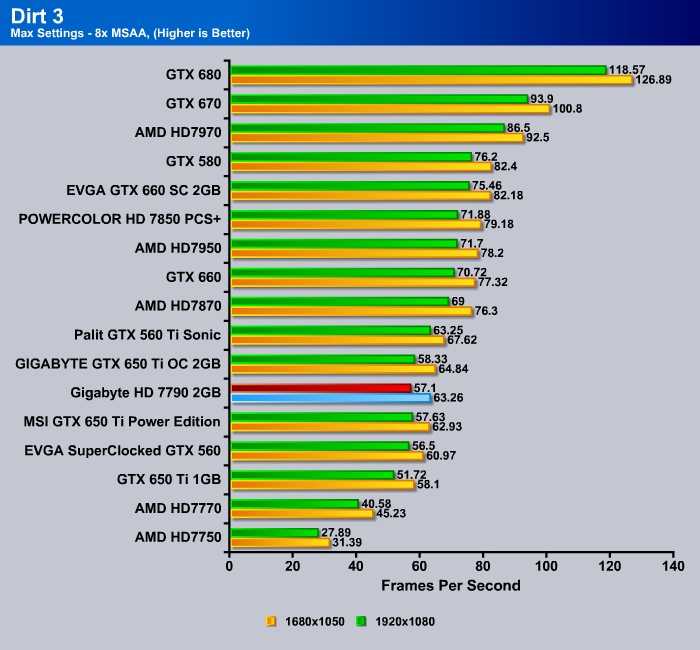
Again, with the HD 7790 and the GTX 650 Ti are essentially tie in Dirt 3.
Temperature and Power Consumption
| GPU Temperatures | Celcius (ºC) |
| Idle | 32 |
| Load | 56 |
When comes to the operating temperature, the Gigabyte HD 7790 excels. The card operates at cool 32ºC idle and even under load, it keeps running cool at temperature below 60ºC. This is much cooler than the cards using AMD reference cooler.
Not only that the temperature of the card is excellent, the noise-level is also equally impressive. Under load, the fan spins at 1700 RPM (52%), which is barely audible in the system. If you are seeking for a quiet gaming card, then this may just be the card you are looking for.
| System Power Consumption | Watts(W) |
| Idle | 60 |
| Load | 217 |
We see the system’s idle power consumption is 60 watts and under load with Metro 2033, it consumes 217 watts of power. Keep in mind that the power consumption we measured is the system power consumption and not just the GPU. One of the unique feature with current generation of AMD video cards is the ZeroCore Power technology. When the connected display is in power saving mode, the GPU will shut most parts down for ultra-low idle power consumption. While the technology may not going to have such a great effect for a single display, it certainly would come in handy for multiple GPU configuration where if the second card is not being used, it will shut down to reduce power consumption. So you can expect the idle temperature to be even lower if the display in standby mode.
Overclocking
We had high hopes with overclocking of the Gigabyte’s HD 7790 since the card runs extremely cool even under load. Unfortunately, it appears that the card suffered the same issue as every other HD 7790 that it cannot be oveclocked passed what AMD’s own OverDrive limitation of 1200 MHz core and 1600 MHz memory. The limitation seems to be set by the card’s BIOS and no matter what software we use, we just could not get it any higher speed. In the past, we were able to push other AMD cards with the Sapphire TriXXX for higher speed. However, with the HD 7790, the setting just return back to 1200MHz and 1600MHz despite the fact the software allows us to raise to higher value. We are a bit sadden to see that with such a great cooling solution could not provide us with an amazing overclocking potential.
Conclusion
If we have to be picky, we would like see the Gigabyte HD 7790 to come in the reference card’s length of 8.5 inches as oppose to 10.5 inches long. We think Gigabyte can actually rework the cooler slightly to fit the reference PCB as oppose to extend the length of the card. Heck, we even would not mind trading maybe a bit of cooling performance for a slightly shorter card. Especially since the card’s oveclocking is limited.
Overall, the Gigabyte HD 7790 2GB (GV-R779OC-2GD) offers good bang for the bucks. Despite its design shortcoming, it is still a good mainstream gaming card as long as you are not going to put it inside a small form factor PC then you can enjoy super quiet operation during the intensive gaming battle.
| Pros | Cons |
|
Good cooling performance Low noise-level Good performance 3 year warranty Multiple monitor support–up to 6 displays 2GB GDDR5 memory Low power consumption Factory overclocked |
10.5 inches long Limited overclocking potential |
Benchmarks — Nexuiz
Nexuiz
Version and / or Patch Used: Latest Steam Update
Timedemo or Level Used: Built in Benchmark
Developer Homepage: http://www.alientrap.org/
Product Homepage: http://www.nexuiz.com/
Nexuiz is an Arena First Person shooter coming soon to consoles. Nexuiz is fast paced with extremely competitive game play. IllFonic brings Alientrap Software’s Nexuiz to next-gen gaming consoles around the world while staying true to the game play refined over the years through development. IllFonic introduces a new Victorian influenced art style that is simultaneously futuristic and sophisticated. Nexuiz for consoles is powered by CryENGINE 3.
While we see a little bit of movement under Nexuiz, performance on a whole is just way to low.
Introduction and Package
VIEW GALLERY — 32 IMAGES
While GIGABYTE is a name we hear a lot about at TweakTown when it comes to the motherboards, it’s been over a year since we’ve looked at a video card from the company. Today, though, we’ve got a chance to look at the new Radeon HD 7790 that AMD has just released from GIGABYTE to see just what they’ve been up to since we last crossed paths.
At launch we looked at the Sapphire HD 7790 1GB Dual-X and found ourselves impressed with what AMD was offering with the new GPU and what Sapphire had done with it. Since that was an OC model and today the GIGABYTE video card we’re looking at also is an OC model, we’ve decided to look at the overclocking side of things.
It will be interesting to see what goes on with performance when it comes to overclocking, but as always there are a few things that we need to do before we’ve got a chance to do that. The first thing we’ll take a look at is the box and the bundle that GIGABYTE is offering. From there we’ll move onto the video card itself to see what kind of cooler setup is on offer.
From the card we’ll get into the specification side of things where we’ll cover the out of the box clock speeds along with the overclock speeds that we managed to achieve. Finally we’ll take a look at our testbed, cover the cards that you’ll see in our graphs today and finally see what’s going on with performance with the overclocked GIGABYTE HD 7790.
Package
While it’s been a while since we’ve seen a GIGABYTE video card, not much has changed on the package side of things. You can see we’ve got the model on the front along with some of the main features which include the core overclock, the fan they’re using and the amount of memory.
Turning over to the back of the box you can see we’ve got a run down on the fan which is one of the main features. You can also see mention that we’re on a 28nm core, have PCIe 3.0 support along with some of the main features in a number of languages.
As we move inside the box we’ve got a fairly standard mid-range bundle from GIGABYTE here. Along with the Quick Guide and driver CD, you can also see we’ve got a dual Molex to 6-pin PCIe power connector.
Benchmarks — Dirt Showdown
Dirt Showdown
Version and / or Patch Used: Latest Steam Update
Timedemo or Level Used: Built in Benchmark
Developer Homepage: http://www.codemasters.com/uk/
Product Homepage: http://www.codemasters.com/uk/dirtshowdown/360/
DiRT Showdown is the new arcade racing game from the team that brought you the award-winning DiRT series, uncaged in 2012. Pick up and play controls combine with electrifying events, frenzied crowds and stunning graphics to deliver high octane, dive in and drive thrills from event one.
Under Dirt Showdown you can see the Sapphire HD 7790 video card at its stock clocks wasn’t able to give us the numbers we needed. Overclocked, though, with the GIGABYTE model, you can see we move over 60 FPS at 1680 x 1050 and fall just two FPS shy at 1920 x 1200.
Внешний вид и система охлаждения
Длина видеокарты вместе с системой охлаждения Direct CUII составляет 216 мм, что позволит установить ее даже в компактные корпуса формата miniATX и microATX.
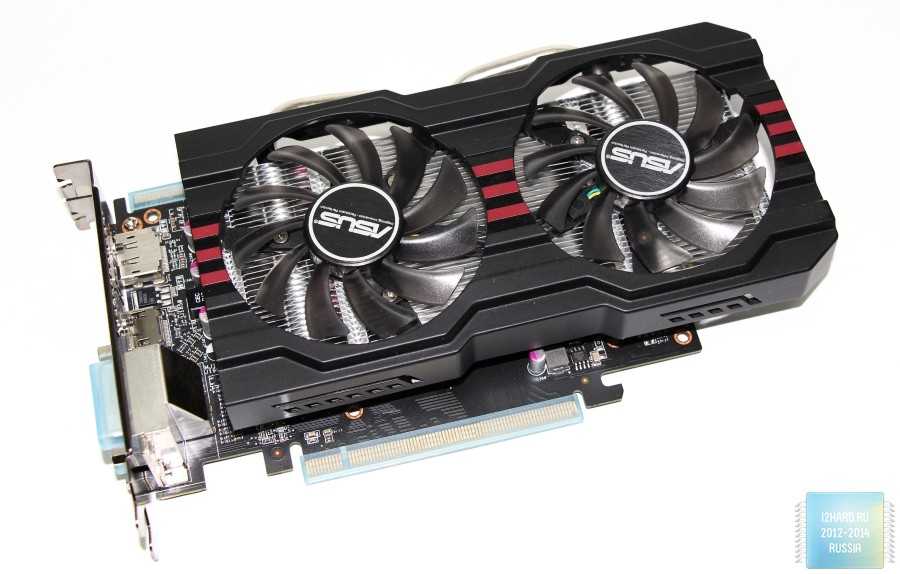
Принципиально ASUS Radeon HD7790 построена на открытой системе охлаждения. То есть видеокарта не имеет никакого кожуха, благодаря чему воздух, нагнетаемый системой охлаждения, соударяясь о плату, выходит с разных сторон. Данный метод охлаждения хорош тем, что на самой плате не создается эффект печки, наоборот, вместе с радиатором охлаждения обдуваются и остальные элементы платы. Длина самой печатной платы видеокарты составляет 177 мм.
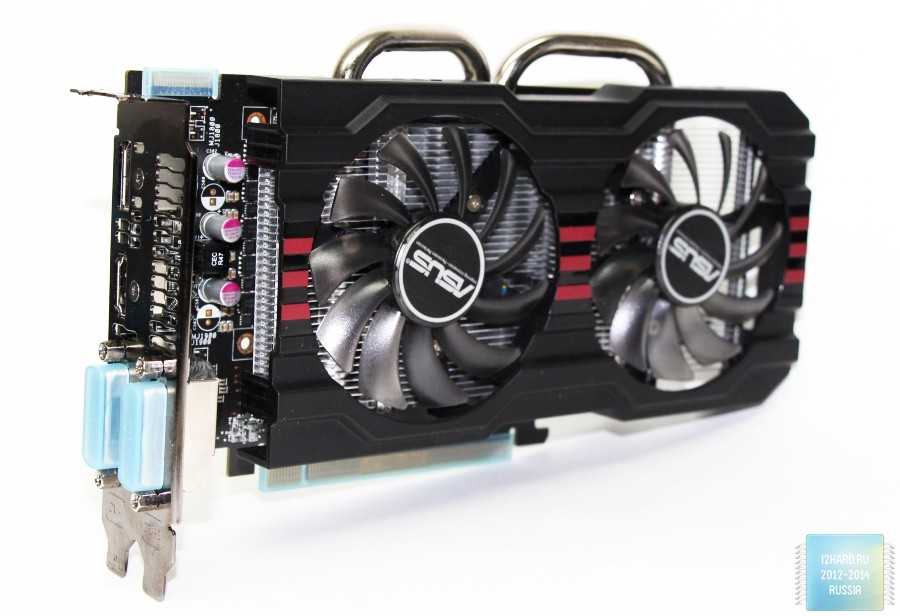
На задней части видеокарты присутствуют два разъема DVI, один из которых DVI-I поддерживает подключение VGA-мониторов через переходник. Также помимо разъемов DVI здесь присутствует разъем HDMI, способный выводить изображение вместе со звуком. Такая реализация одновременного вывода видео и звука через HDMI обязаны присутствию звукового кодека на самой видеокарте. Разъем DisplayPort также имеется на данной видеокарте, и благодаря технологии AMD Eyefinity, он способен выводить изображение сразу на три монитора одновременно.
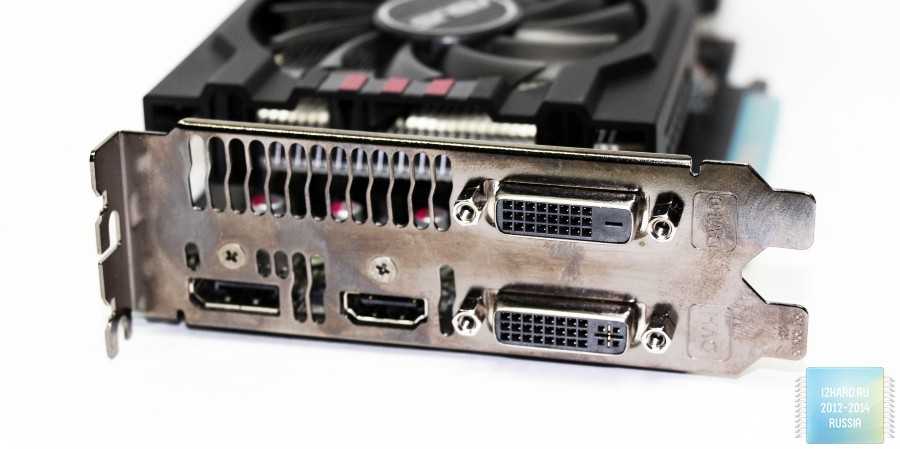
Для обеспечения качественного питания видеокарта оснащена одним разъемом 6-Pin дополнительного питания. Общее потребление видеокарты составляет 102 Вт.
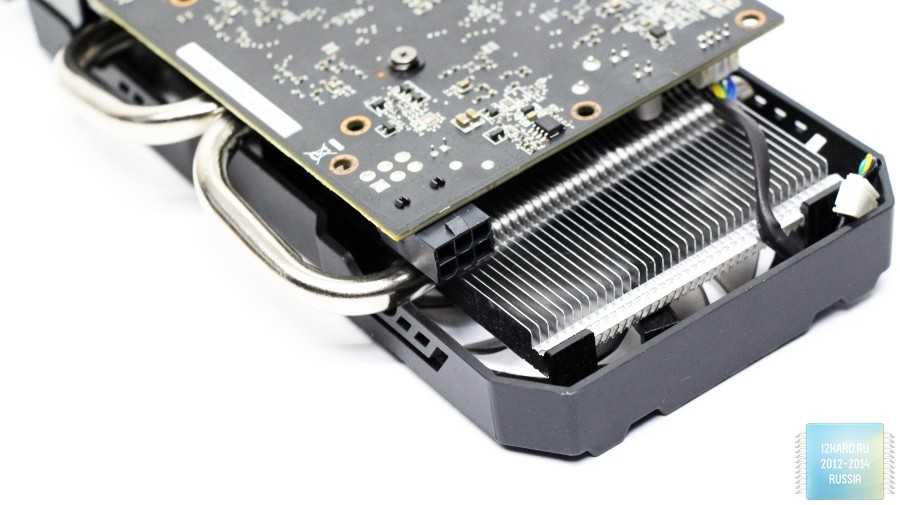
Видеокарта является двухслотовой, для современных систем охлаждения это скорее норма, нежели редкость. Для объединения двух таких видеокарт в связку Crossfire на плате предусмотрен соответствующий разъем для мостика Crossfire.
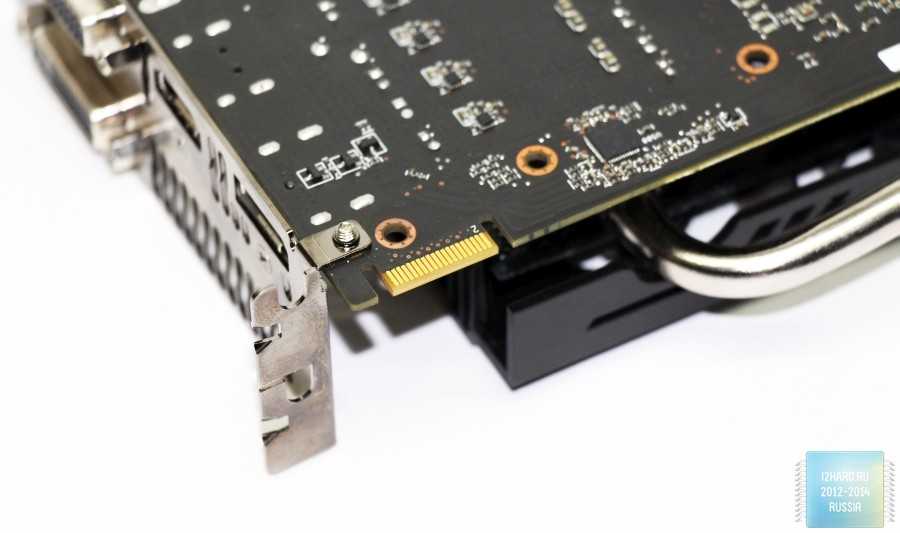
ASUS Radeon HD7790 выполнена на печатной плате черного цвета.
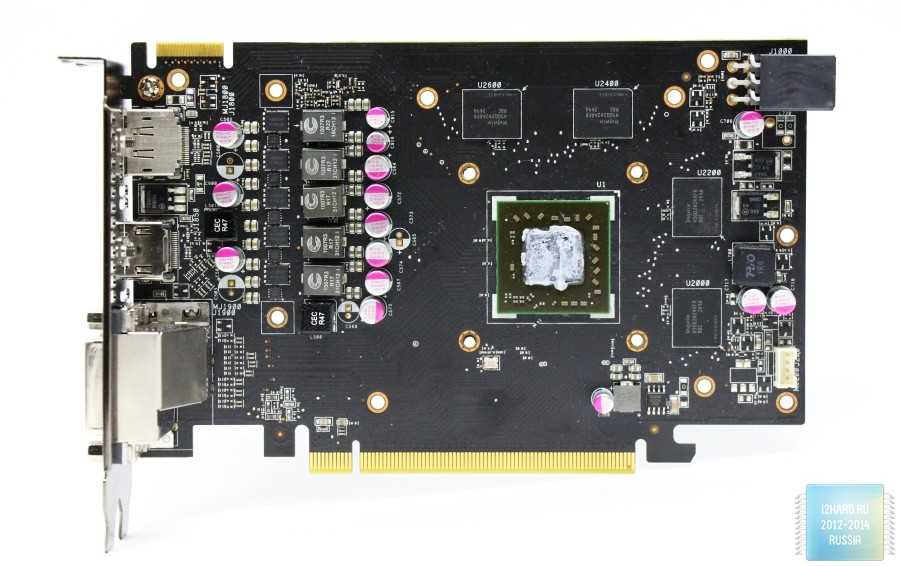
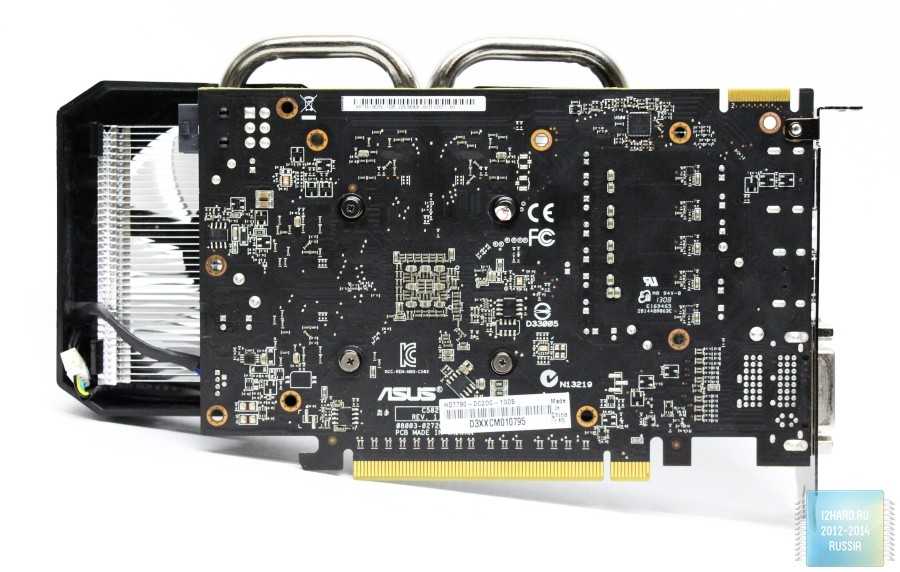
Несмотря на принадлежность видеокарты к бюджетному классу питание графического ускорителя реализовано по схеме 5+1.
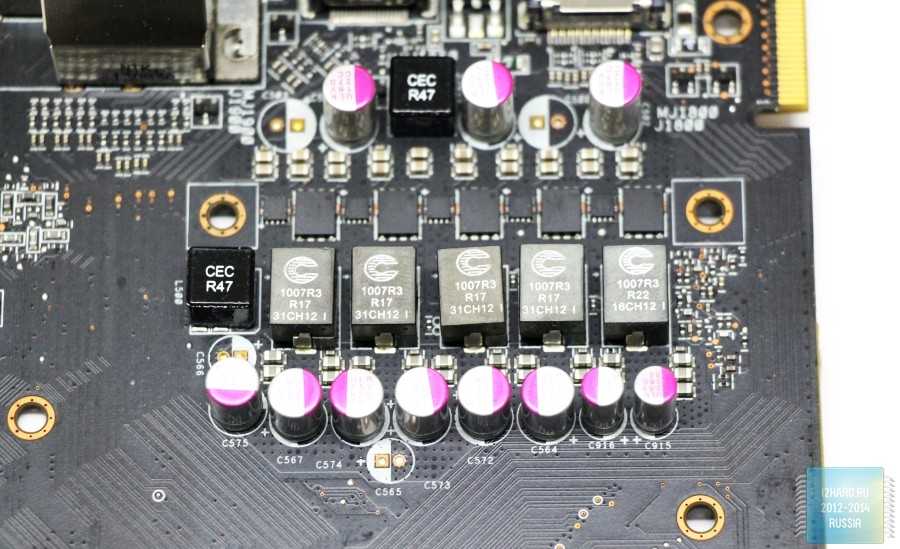
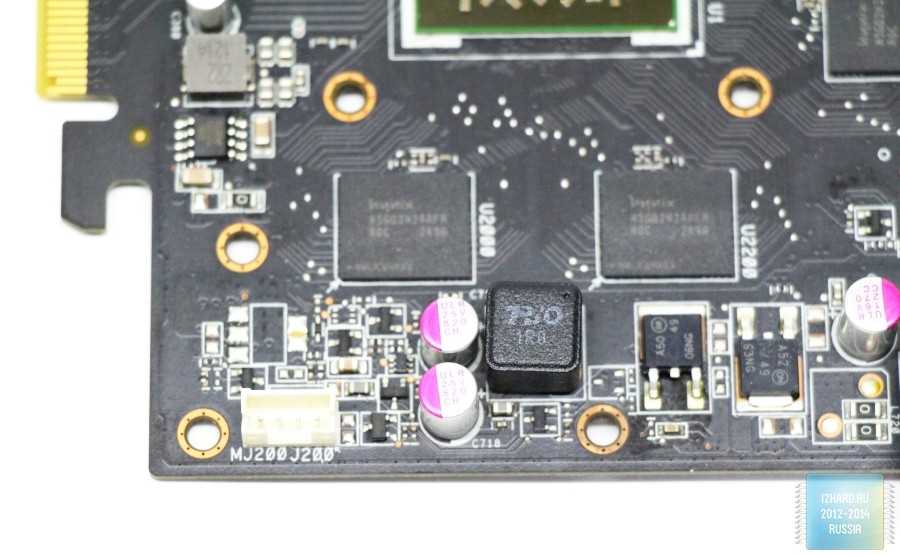
Так, 5 фаз питания отвечают за GPU, и одна фаза за память. Внимательно изучив пространство вблизи фаз питания GPU видно, что печатная плата была сделана с учетом установки радиатора охлаждения на схему питания GPU. Впрочем, в случае ASUS Radeon HD7790 никакого радиатора здесь не наблюдается.
Графический процессор Bonaire, выполненный по 28 нм техпроцессу, смещен чуть вправо от центра печатной платы. Кристалл процессора ничем не защищен, поэтому при съеме и монтаже системы охлаждения следует быть осторожным.
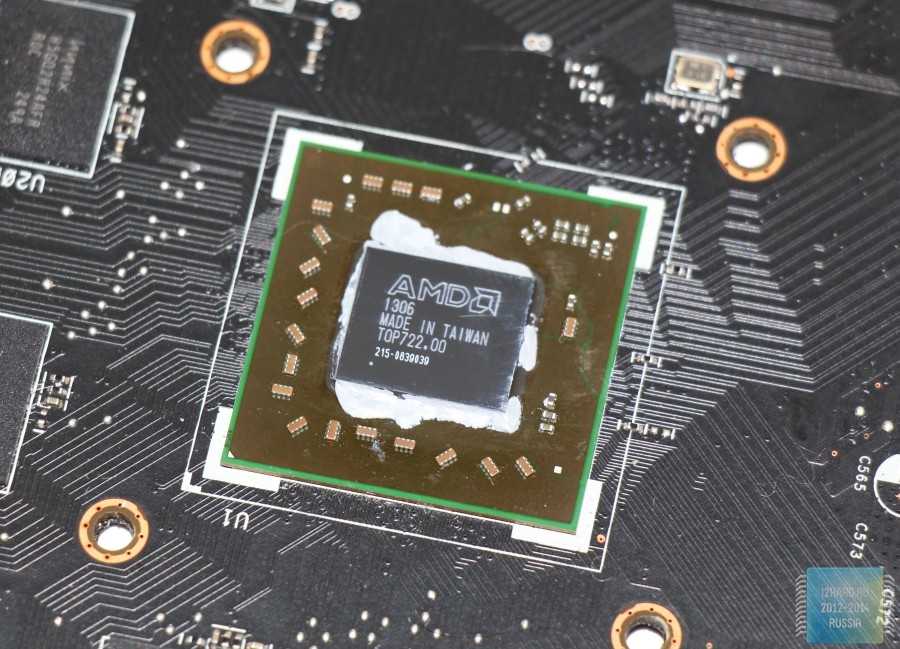
Вокруг GPU размещены микросхемы памяти с маркировкой H5GQ2H24AFR производства Hynix. Общий объем памяти в 1Gb набран четырьмя микросхемами объемом по 256Mb каждая.
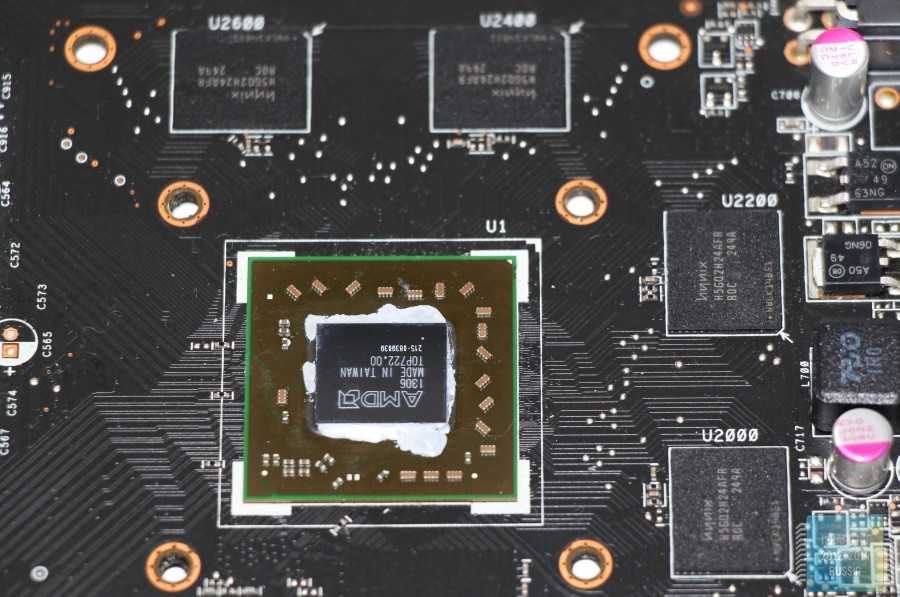
Разъем питания системы охлаждения 4pin, что дает возможность не только отслеживать показания вращения вентиляторов, но и также управлять их оборотами через специальные утилиты.

Сама система охлаждения Direct CUII представляет собой радиатор, состоящий из алюминиевого основания, двух медных никелированных тепловых трубок и 38 алюминиевых пластин.
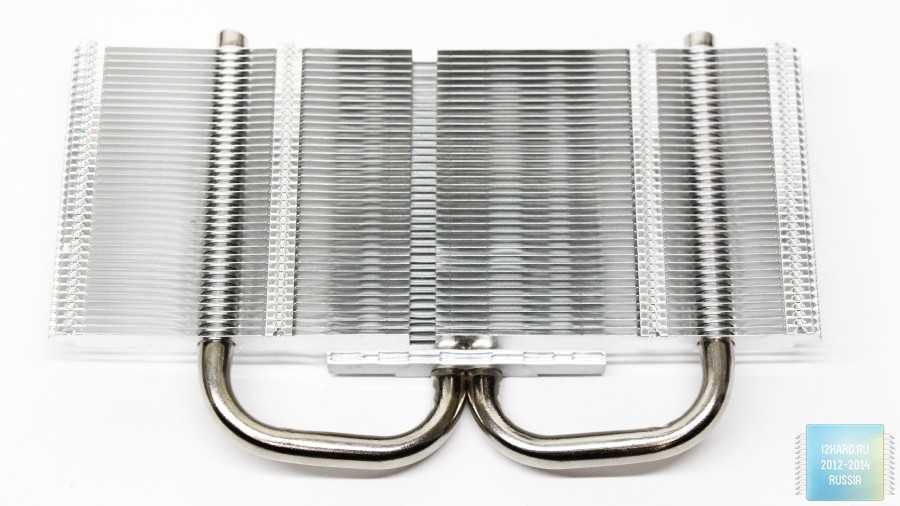
Тепловые трубки толщиной 8 мм напрямую контактируют с кристаллом графического процессора.
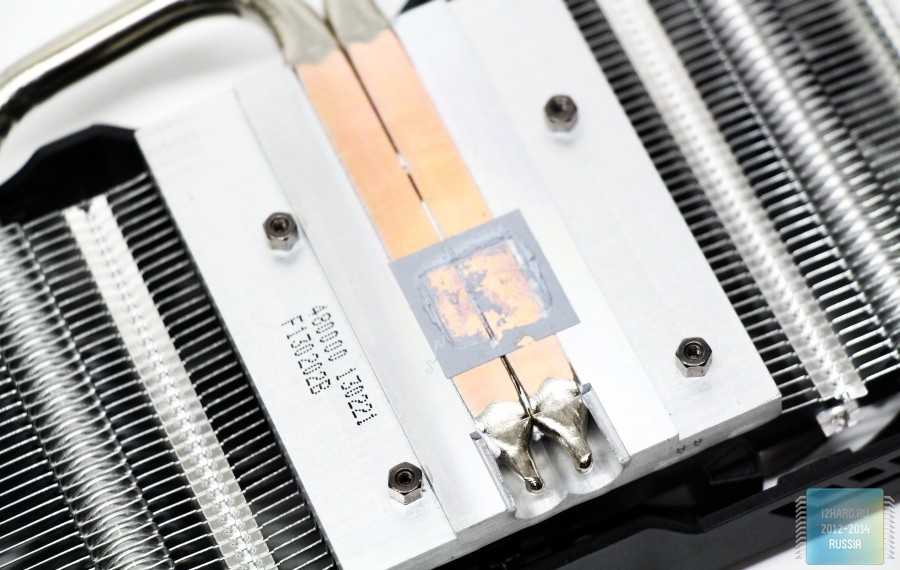
Сверху радиатор системы охлаждения накрывает пластиковая рамка, на которой закреплены два 75 мм вентилятора, которая крепится к радиатору с помощью защелок.
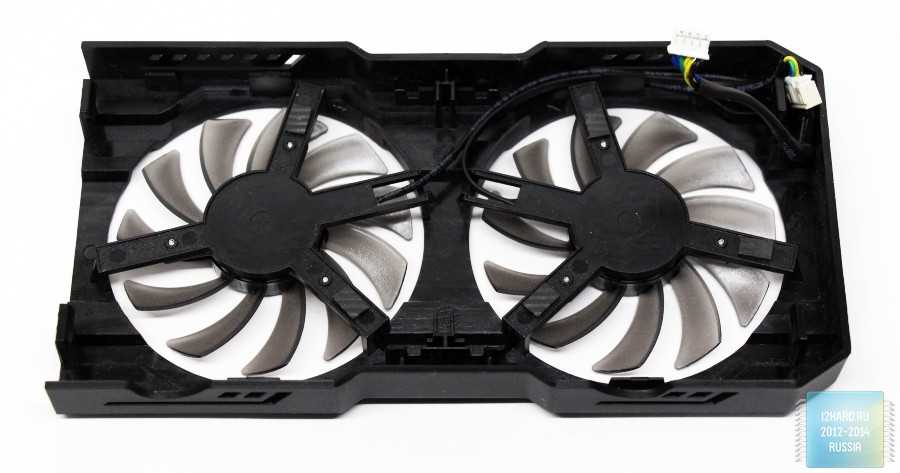
11-лепестковые вертушки обдувают как сам радиатор, так и навесные элементы печатной платы видеокарты.
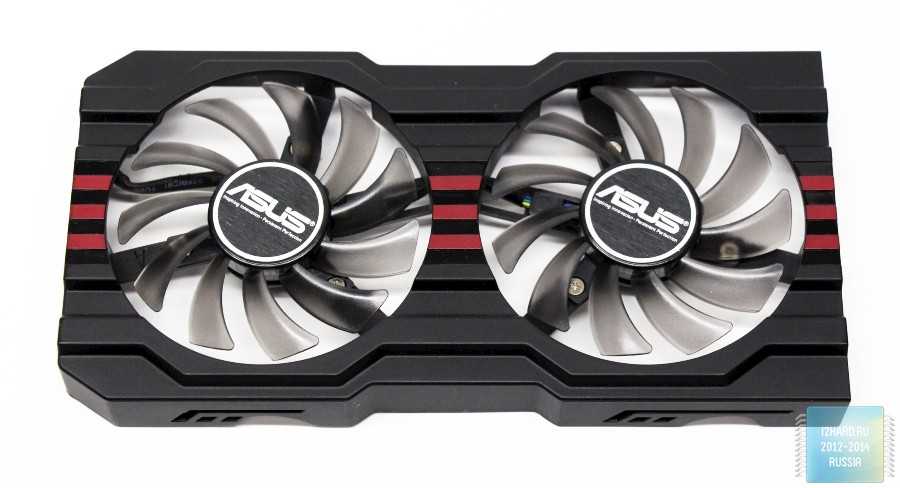
Благодаря такой конструкции, которая является фирменной разработкой компании ASUS, достигается высокая эффективность охлаждения при весьма умеренном шуме.
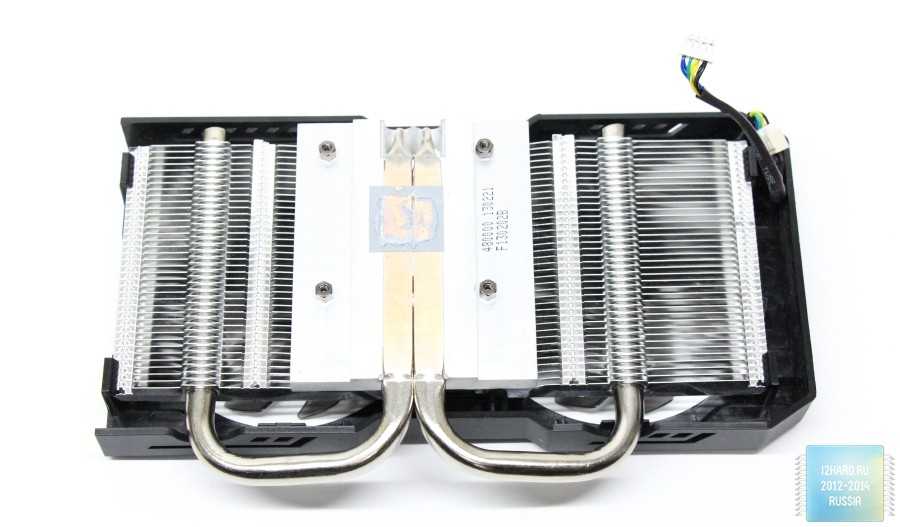
MSI R7790-1GD5/OC
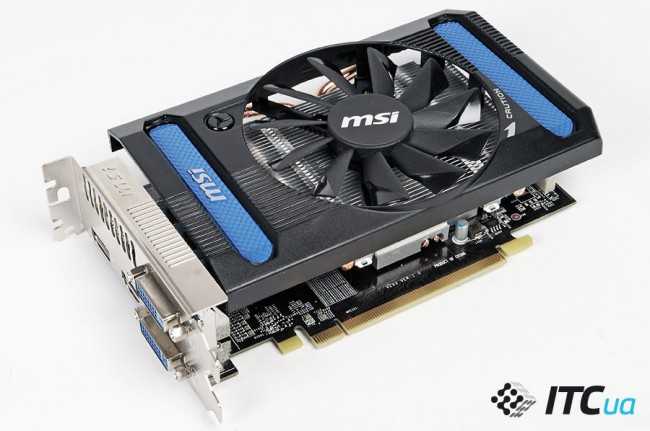
MSI R7790-1GD5/OC
Видеокарты
на
Компания MSI предлагает две модели Radeon HD 7790, которые выполнены на единой базе. Одна из них (R7790-1GD5) имеет частотную формулу, соответствующую рекомендованной, тогда как рассматриваемая модификация OC Edition изначально турбирована производителем. В данном случае графический чип ускорен до 1050 МГц, тогда как память функционирует на базовых 6000 МГц.
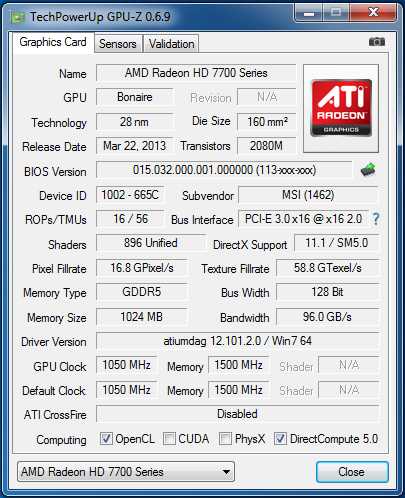
Для видеокарты используется референсная печатная плата длиной 172 мм. На PCB размещена шестифазная (4+1+1) подсистема питания. Основной силовой блок сдвинут к интерфейсной панели. Элементы VRM в данном случае прикрыты сравнительно крупным алюминиевым радиатором.
MSI R7790-1GD5/OC использует оригинальную систему охлаждения. Конечно, это не фирменный TwinFrozr, однако c отводом тепла данная СО должна справляться лучше референсной.
Радиаторный блок не очень велик. Набор алюминиевых пластин «прошит» парой 6-миллиметровых тепловых трубок, которые также имеют прямой контакт с кристаллом GPU. Следы пайки не видны, контакт трубок с основанием и пластинами обеспечивается благодаря плотной прессовке. Радиаторный блок продувается одним крупным 100-милиметровым вентилятором осевого типа, лопасти которого уже традиционно для устройств MSI имеют определенную форму (Propeller Blade), которая, по мнению производителя, позволяет увеличить воздушный поток. Отметим увеличенную крепежную пластину, которая выполняет роль направляющей, позволяя улучшить вывод воздуха за пределы системного блока. На самой панели ожидаемы набор видеовыходов – два DVI, а также HDMI и DisplayPort.
Длина видеокарты – 187 мм. Разъем питания расположен на верхней кромке PCB, потому адаптер от MSI удастся установить даже в очень компактный корпус, конечно, если нет значительных ограничений по ширине.
В комплекте ничего лишнего: диск с драйверами, руководство по быстрой установке, переходник DVI-VGA и переходник c пары Molex на шестиконтактный коннектор 12 В.
Проверка эффективности системы охлаждения показала, что в режиме покоя компактного радиатора и 100-миллиметрового вентиляторного громилы хватает для того, чтобы температура чипа не превышала 24 градуса (сделаем скидку на открытый стенд и ~ +20 С в помещении на момент теста). Обороты можно было бы и пониже задать, 1300 об/мин кажутся избыточными. Равно как и 1750 об/мин, которые вентилятор развил на пике, удерживая температуру GPU на уровне 52 С. Не то, чтобы в таком режиме кулер издавал существенный шум, но учитывая столь невысокий нагрев GPU, алгоритм работы можно было бы сделать еще менее агрессивным.
Benchmarks — Sniper Elite V2
Sniper Elite V2
Version and / or Patch Used: Standalone Benchmark
Timedemo or Level Used: Built in Benchmark
Developer Homepage: http://www.rebellion.co.uk/
Product Homepage: http://sniperelitev2.com/us/age.html
Sniper Elite V2 features detailed sniping simulation with advanced ballistics, taking into account gravity, wind, velocity, bullet penetration, aim stability and more. Guaranteed to provide players with the most realistic simulation of military sharpshooting yet available.
Sniper Elite V2 sees some good gains, but at the lowest resolution we’re only seeing an average of 55 FPS. We’d only need a small detail adjustment, though, to bring those numbers up to 60 FPS at this resolution. 1920 x 1200 is going to need slightly more, though, to get from up the 47 FPS average.
Power Consumption Test
Using our PROVA Power Analyzer WM-01 or «Power Thingy» as it has become quickly known as to our readers, we are now able to find out what kind of power is being used by our test system and the associated graphics cards installed. Keep in mind; it tests the complete system (minus LCD monitor, which is plugged directly into AC wall socket).
There are a few important notes to remember though; while our maximum power is taken in 3DMark06 at the same exact point, we have seen in particular tests the power being drawn as much as 10% more. We test at the exact same stage every time; therefore tests should be very consistent and accurate.
The other thing to remember is that our test system is bare minimum — only a SSD hard drive is used with a single CD ROM and minimal cooling fans.
So while the system might draw 400 watts in our test system, placing it into your own PC with a number of other items, the draw is going to be higher.
Power draw numbers look good. You can see that while load is pretty much in line with what we saw from the Sapphire offering, the idle number is slightly lower on the GIGABYTE offering.
Benchmarks — F1 2012
F1 2012
Version and / or Patch Used: Latest Steam Update
Timedemo or Level Used: Built in Benchmark
Developer Homepage: http://www.codemasters.com/uk/
Product Homepage: http://www.codemasters.com
In F1 2012 players will feel the unparalleled thrill of becoming a FORMULA ONE driver with a host of new features, wide-ranging technical and gameplay advancements and extensive competitive and co-operative multiplayer components. F1 2012 will feature all of the official teams, drivers and circuits from the 2012 FIA FORMULA ONE WORLD CHAMPIONSHIP, including the debut of the 2012 FORMULA 1 UNITED STATES GRAND PRIX at Austin, Texas and the return of Germany’s famous Hockenheim circuit to the calendar.
F1 2012 also sees some good gains across the board with more breathing room being seen at 1920 x 1200 and 1680 x 1050. While we also see an almost 10% gain at 2560 x 1600, you can see the 54 FPS number falls shy of that 60 FPS one we’re always on the hunt for.
Let’s Compare the Market
Tackling the on-paper specifications first, the trio of partner cards all push the core speed up from 1,000MHz to 1,075MHz. Perusing other partners’ HD 7790 offerings intimates that AMD isn’t allowing higher core speeds at the moment. Gigabyte and PowerColor keep their cards’ memory humming along at a reference 6,000MHz, but Sapphire increases it to 6,400MHz — or a 6.7 per cent hike.
At 215mm Sapphire’s card is the longest, followed by the PowerColor Turbo Duo and, about an inch shorter, the Gigabyte OC. All cards use dual-slot cooling, though Gigabyte opts for a single large fan as opposed to the standard dual 80mm fans we routinely see on mid-range cards.
The trio have the same video outputs, per AMD’s recommendation, but Sapphire is the only one to go further and include built-in circuitry that enables the two DVI ports and HDMI to be connected to three monitors without the need for extra adapters. Sapphire also has the most comprehensive bundle, and if purchased from authorised retailers, all cards ship with a redeemable coupon code for the rather excellent BioShock Infinite.
Sapphire appears to have the edge when viewed by specifications alone, though do understand that the press samples we receive may not tally up with the stock etailers hold: our particular package’s model number is 11210-01-40G. Let’s take a look at each card in turn before we run them through the benchmarks.
PowerColor AX7790 1GBD5-TDH/OC TurboDuo
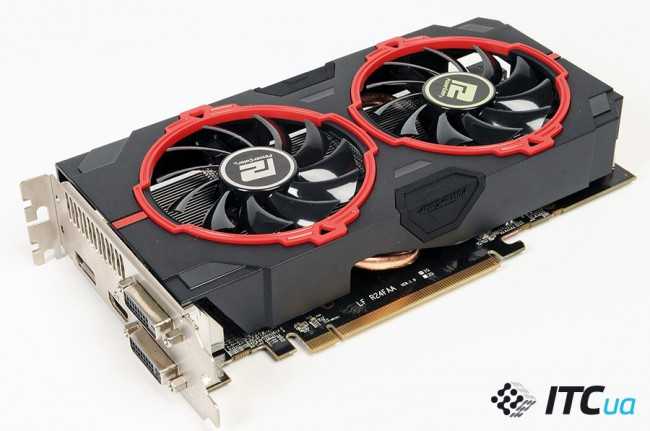
PowerColor HD7790 1 GB OC AX7790 1GBD5-TDH/OC
Видеокарты
на
В ассортименте PowerColor изначально появилось целых три модели Radeon HD 7790. На наш взгляд, на тестирования попала наиболее интересная модификация, оснащенная оригинальным кулером TurboDuo и имеющая увеличенную тактовую частоту графического процессора (1075 МГц).
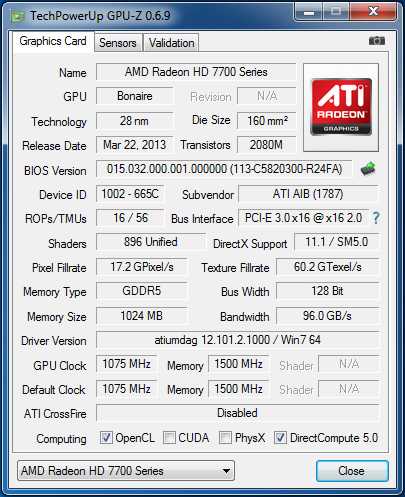
Компоновка печатной плата очень схожа с таковой для референсной, однако в данном случае длина PCB увеличена до 210 мм, к тому же видны некоторые отличия в разводке ряда элементов. Компоненты силового блока дополнительно охлаждаются небольшим радиатором. Два характерных выреза на PCB по классификации производителя называются не иначе как Aerodynamics Kit. Предполагается, что такое решение улучшает вентиляцию, тем самым ускоряя отвод тепла.
Конструкция кулера TurboDuo в целом довольно привычна. В основе теплосъемник и набор алюминиевых пластин, увеличивающих площадь рассеивания. S-образная тепловая трубка (диаметр 6 мм), имеющая прямой контакт с чипом, помогает эффективнее распределить тепло на удаленные участки охладителя.
Радиаторный блок продувается двумя вентиляторами диаметром 80 мм. Сверху кулер прикрыт массивным пластиковым кожухом черного цвета с декоративными тороидальными пластинками красного цвета вокруг отверстий для вентиляторов, а также резиновыми вставками с логотипом компании.
По своему содержанию интерфейсная панель не отличается от уже рассмотренных – пара DVI, а также полноформатные HDMI и DisplayPort.
Комплект поставки минимально достаточный – диск, руководство и переходник DVI-VGA. Устройство поставляется в эффектной упаковке с выпрессованной на плексигласовом вкладыше надписью TurboDuo. По ее внешнему виде легко определить, коробка с какой модификацией Radeon HD 7790 у вас в руках.
Тестирование возможностей системы охлаждения показали, что кулер в режиме покоя способен удерживать температуру графического процессора на уровне 28 градусов при скорости вращения вентиляторов на уровне 1450 об/мин. Под нагрузкой чип прогревается до 62 градусов, а обороты вентиляторов увеличиваются вплоть до 2100 об/мин. Общий уровень издаваемого шума можно охарактеризовать как «ниже среднего», однако два других участника обзора работают еще тише (особенно, модель от ASUS).
MSI и PowerColor рекомендуют использовать для систем с Radeon HD 7790 блоки питания мощностью от 500 Вт, а для платформ с парой таких видеокарт – 600 Вт. В перечне системных требований на коробке с графическим адаптером ASUS указаны минимальные требования к БП – 400 Вт и способность обеспечить ток до 24 А по линии 12 В. Учитывая довольно скромные TDP устройств на Bonaire, последнее значение кажется вполне оправданным.
Страница 1: Тест и обзор: Gigabyte Radeon HD 7790
Слухи о видеокарте Radeon HD 7790 начали циркулировать довольно давно, но она появилась на рынке даже раньше, чем ожидалось. В нашу тестовую лабораторию поступила первая розничная видеокарта Gigabyte Radeon HD 7790, которую мы подвергли традиционному пристальному тестированию. Хотя из-за нехватки времени и некоторых технических сложностей нам придётся опустить часть деталей.
Gigabyte Radeon HD 7790 — первая карта нового семейства. Мы надеемся получить другие образцы в ближайшие недели, что позволит опубликовать полноценное сравнение. По тестам нам тоже пришлось пойти на некоторые ограничения. Наша учетная запись Steam была заблокирована на протяжении всего дня, поэтому мы не смогли провести соответствующие тесты. Мы наверстаем упущенное чуть позднее.
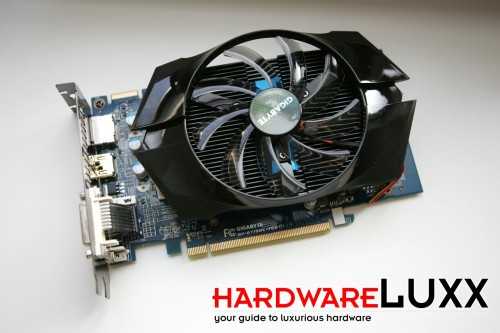
» Fotostrecke
Перед тем, как мы представим видеокарту Gigabyte Radeon HD 7790 в деталях и проведём её через наш тестовый пакет, позвольте поговорить об архитектуре GPU.
Базовая информация об архитектуре
Кристалл Bonair
Для видеокарты Radeon HD 7790 AMD приготовила полностью новый чип с кодовым названием «Bonaire». Он располагается между Radeon HD 7770 и 7870. Новый GPU выпускается по 28-нм техпроцессу и содержит 2,08 млрд. транзисторов. Размер кристалла AMD составляет 160 мм². Новый графический процессор содержит 14 вычислительных блоков (Compute Units), которые дают, в общей сложности, 896 потоковых процессоров. AMD для эталонной версии видеокарты выбрала частоту 1000 МГц, но Gigabyte для своей модели выставила 1075 МГц. 1024 Мбайт памяти GDDR5 у AMD работает на частоте 1500 МГц, той же спецификации придерживается и Gigabyte.
AMD PowerTune
AMD указывает максимальное энергопотребление 85 Вт. Вычислительная мощность 1,79 TFLOPS радует, но вряд ли она имеет решающее значение для видеокарты данного класса. Интереснее то, что в AMD «Bonaire» реализована новая технология PowerTune. У всех современных GPU используется четыре состояния чипа, а именно «Low State», «Intermediate State», «High State» и «Boost State». Состояние «High State» также описывает и другие так называемые «Interred State», которые работают с более высоким напряжением P-состояний.
AMD PowerTune
В случае Radeon HD 7790 AMD улучшила технологию PowerTune, которая теперь использует восемь фиксированных P-состояний с заданным напряжением и тактовыми частотами. Преимущество заключается в более быстром переключении между новыми P-состояниями, чем раньше.
AMD PowerTune
Возможно, AMD приготовила нам предварительную версию того, что мы увидим ближе к Новому году на high-end сегменте.
| Gigabyte Radeon HD 7790 | |
|---|---|
| Розничная цена | От 139 евро в Европе |
| Сайт производителя | www.gigabyte.ru |
| Технические спецификации | |
| GPU | Bonaire |
| Техпроцесс | 28 нм |
| Число транзисторов | 2,08 млрд. |
| Тактовая частота GPU (базовая частота) | 1075 МГц |
| Тактовая частота GPU (частота Boost) | 1075 МГц |
| Тактовая частота памяти | 1500 МГц |
| Тип памяти | GDDR5 |
| Объём памяти | 1024 Мбайт |
| Ширина шины памяти | 128 бит |
| Пропускная способность памяти | 96 Гбайт/с |
| Версия DirectX | 11.1 |
| Потоковые процессоры | 896 (1D) |
| Текстурные блоки | 56 |
| ROPs | 16 |
| Пиксельная скорость заполнения | 17,2 Гпиксель/с |
| SLI/CrossFire | CrossFire |
Перед тем, как мы приступим к тестированию Gigabyte Radeon HD 7790, позвольте рассмотреть тестовую видеокарту более подробно.
<>Тест и обзор: Gigabyte Radeon HD 7790Radeon HD 7790 | Тестовый образец в деталях
Benchmarks — Metro 2033
Metro 2033
Version and / or Patch Used: Latest Steam Update
Timedemo or Level Used: Built in Benchmark
Developer Homepage: http://www.4a-games.com/
Product Homepage: http://www.thqnordic.com/
Metro 2033 is an action-oriented video game with a combination of survival horror and first-person shooter elements. The game is based on the novel Metro 2033 by Russian author Dmitry Glukhovsky. It was developed by 4A Games in Ukraine and released in March 2010 for Microsoft Windows and Xbox 360. In March 2006, 4A Games announced a partnership with Glukhovsky to collaborate on the game. The game was announced at the 2009 Games Convention in Leipzig; a first trailer came along with the announcement. A sequel was announced, currently titled Metro: Last Light.
While you can see those strong gains again we’re not quite able to break the 60 FPS mark at 1920 x 1200 and 2560 x 1600. You can see at 1680 x 1050, though, we move from 61 FPS to 67 FPS average, giving us some more breathing room, which is always appreciated.
Тестирование в бенчмарках и играх
В соперники ASUS Radeon HD7790 для сравнения была взята видеокарта классом выше, а именно ASUS GeForce GTX670. И несмотря на то, что силы этих видеокарт далеко не равны и последняя дороже HD7790 в два раза, тем не менее, будет интересно сравнить их лицом к лицу и сделать соответствующие выводы.
Тесты в бенчмарках Heaven Benchmark 4.0, Valley Benchmark, 3D Mark 11 и 3D Mark 13 были проведены при дефолтных настройках. Настройки графикиво всех играх были установлены на максимально возможные значения, разрешение дисплея — 1920 х 1080. В игре Tomb Raider тесты были проведены с активированной технологией AMD TressFX. Во всех графиках игр указаны средние значения FPS.
3D Mark 11
3D Mark 13
Tomb Raider
Несмотря на безоговорочное лидерство GeForce GTX670, видеокарте ASUS AMD Radeon HD7790 есть что предложить геймерам. Ведь посудите сами, при тестировании на максимальных настройках графики в самых современных играх Radeon HD7790 выдает уровень производительность близкий к играбельному. Так и есть, видеокарта среднего ценового уровня не рассчитана на то, что купив ее пользователь сможет играть на самых высоких настройках. А если опустить настройки в играх на средние — то пожалуйста. Что касается прямого сравнения с GeForce GTX670, то стоит сказать, что преимущество одной видеокарты над другой прямо пропорционально разнице в их стоимости.
Benchmarks — Lost Planet 2
Lost Planet 2
Version and / or Patch Used: Standalone Benchmark
Timedemo or Level Used: Built in Benchmark — Test A Scene 1
Developer Homepage: http://www.capcom.com/
Product Homepage: http://www.lostplanet2game.com/
Lost Planet 2 is a third-person shooter video game developed and published by Capcom. The game is the sequel to Lost Planet: Extreme Condition which is also made by Capcom, taking place ten years after the events of the first game, on the same fictional planet. The story takes place back on E.D.N. III 10 years after the events of the first game. The snow has melted to reveal jungles and more tropical areas that have taken the place of more frozen regions. The plot begins with Mercenaries fighting against Jungle Pirates. After destroying a mine, the Mercenaries continue on to evacuate the area, in which a Category-G Akrid appears and attacks them. After being rescued, they find out their evacuation point (Where the Category-G appeared) was a set-up and no pick up team awaited them. The last words imply possible DLC additions to the game, «There’s nothing to be gained by wiping out snow pirates… unless you had some kind of grudge.»
Lost Planet 2 across the board sees gains of around 10%. Unfortunately while they’re not enough to bring us to 60 FPS, you can see that at 1680 x 1050 we manage to score a strong 59 FPS.
Benchmarks — Phantasy Star Online 2
Phantasy Star Online 2
Version and / or Patch Used: Standalone Benchmark
Timedemo or Level Used: Built in Benchmark
Developer Homepage: http://www.sega.com/?t=EnglishUSA
Product Homepage: http://www.pso2.com/us/html/index.html
Play Phantasy Star Online 2 and experience revolutionary combat in an action-driven, free-to-play multiplayer online RPG from SEGA. Take a journey into an immersive sci-fi fantasy narrative and explore mysterious worlds to unravel their secrets. Join fellow adventurers and fight against the legions of darkness to banish them from the galaxy.
Score explanation: Less than 2000: Please adjust your game settings because the processing load is quite heavy.
2000 through 5000: The game runs fine at the setting, if you have room, you can adjust some settings.
5001+: The game works wonderfully at this setting.
PSO2 sees a really nice boost in performance and you can see we get a whole lot of extra breathing room as we climb towards 2500 points. Considering we’re benching at 2560 x 1600 here, we’ve really got a ton of head room to move.
Benchmarks — Tomb Raider
Tomb Raider
Version and / or Patch Used: Latest Steam Update
Timedemo or Level Used: Built in Benchmark
Developer Homepage: http://www.nixxes.com/
Product Homepage: http://www.tombraider.com/us/base/agegate?refer=184&
Tomb Raider is an action-adventure platform video game. Published by Square Enix, Tomb Raider is the fifth title developed by Crystal Dynamics in the Tomb Raider franchise. As the first entry in a new Tomb Raider continuity, the game is a reboot that emphasizes the reconstructed origins of the culturally influential lead character Lara Croft. Tomb Raider was released on 5 March 2013 for PlayStation 3, Xbox 360 and Microsoft Windows to universal critical acclaim.
Tomb Raider doesn’t really benefit at all from the overclocking and you can see we get a slightly dip in performance at the highest resolution. Overall the game remains unplayable here at stock and overclocked.
Benchmarks — Unigine Heaven Benchmark
Unigine Heaven Benchmark
Version and / or Patch Used: 3
Developer Homepage: http://www.unigine.com
Product Homepage: http://unigine.com/press-releases/091022-heaven_benchmark//
New benchmark grants the power to unleash the DirectX 11 potential in the gift wrapping of impressively towering graphics capabilities. It reveals the enchanting magic of floating islands with a tiny village hidden in the cloudy skies. With the interactive mode emerging experience of exploring the intricate world is ensured within reach. Through its advanced renderer, Unigine is one of the first to set precedence in showcasing the art assets with tessellation, bringing compelling visual finesse, utilizing the technology to the full extend and exhibiting the possibilities of enriching 3D gaming.
Looking at Heaven performance we can again see a very nice boost in performance which sees the gap between the HD 7790 and HD 7850 close quite a bit.
Benchmarks — High Quality AA and AF
High Quality AA and AF
While we test all our games with maximum in-game settings, turning on Anti-Aliasing (AA) and Antistrophic Filtering (AF) helps take the intensity of our testing to another level.
Here we see video cards go from playable FPS to an unplayable FPS and the real power houses continue to help break that 60 FPS mark we always aim for to provide a smooth gaming experience.
You can see under Far Cry 2 that our overclock helps break the 30 FPS / 60 FPS barrier at 1920 x 1200. 2560 x 1600 numbers remain too low still.
Under our other benchmarks you can see we’ve got a bit of a performance bump, but on the whole, there’s nothing that moves us from unplayable to playable.
Вывод
Отличная эффективность фирменной системы охлаждения Direct CUII, компактные размеры и приемлемый уровень производительности в современных играх подталкивают смело к тому, чтобы проголосовать при выборе видеокарты в пределах 4000-4200 рублей за ASUS AMD Radeon HD7790 рублем. Графический ускоритель Radeon HD7790 с успехом удовлетворит потребности экономных геймеров, желающих получить достаточный уровень производительности при средних настройках даже в самых мощных проектах. А возможность построения связки CrossFire из двух таких видеокарт позволит обладателю Radeon HD7790 увеличить производительность в будущем путем добавления второй видеокарты в систему.
Плюсы:
- приемлемая производительность;
- эффективная система охлаждения Direct CUII;
- 3 года гарантии;
- система питания по системе 5+1;
- низкие требования к мощности блока питания;
- низкий уровень шума.
Минусы:
отсутствие защитной рамки графического ядра.
Заотличную систему охлаждения и приемлемую производительность в играх видеокарта ASUS AMD Radeon HD7790 награждается наивысшей оценкой нашей редакции i2Hard — золотой медалью.





























